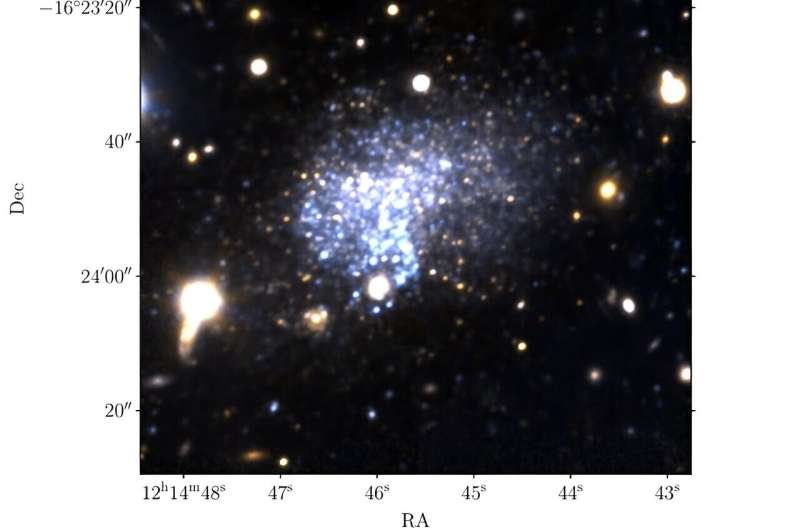July 15, 2024 report
This article has been reviewed according to Science X's editorial process and policies. Editors have highlighted the following attributes while ensuring the content's credibility:
fact-checked
preprint
trusted source
proofread
New low-mass galaxy discovered

Astronomers report the discovery of a new galaxy in the constellation Corvus. The newfound galaxy, which received designation Corvus A, has a relatively low mass, is gas-rich and isolated. The discovery was presented in a research paper published July 3 on the pre-print server arXiv.
One of the projects that has detected many nearby low-mass galaxy candidates is the SEmi-Automated Machine LEarning Search for Semi-resolved galaxies (SEAMLESS). The project relies on masking high surface brightness emission from stars and bright galaxies and then filtering the images on a variety of scales in order to identify faint, extended sources.
Corvus A was first identified in the Dark Energy Spectroscopic Instrument (DESI) legacy imaging surveys. Recently, a team of astronomers led by Michael G. Jones of the University of Arizona in Tucson, has conducted follow-up observations of this object using such facilities as the Magellan Clay telescope or Karl G. Jansky Very Large Array (VLA), which allowed them to confirm the low-mass galaxy status for Corvus A.
"Corvus A is a newly-discovered low-mass galaxy identified during the initial phase of the SEAMLESS project," the researchers wrote.
The observations found that the stellar body of Corvus A has an irregular structure and its light is dominated by a region of young blue stars on its eastern side. Therefore, the astronomers underlined that its blue, clumpy, and irregular appearance is reminiscent of Leo P—a small star-forming irregular galaxy in the constellation Leo, one of the least massive in the Local Group as its stellar mass is estimated to be about 560,000 solar masses.
According to the paper, Corvus A, with a half-light radius of 834 light years, is only a few times more massive than Leo P and contains many young stars with an age not exceeding 200 million years. The study found that Corvus A is a gas-rich galaxy with no regions of ionized interstellar atomic hydrogen—the so-called H II regions.
The distance to Corvus A was measured to be some 11.3 million light years. It also turned out that there are no other galaxies within approximately 3.3 million light years from Corvus A, which makes it a remarkably isolated galaxy.
The astronomers noted that the proximity of Corvus A makes it an excellent target for higher resolution follow-up observations at both radio and optical wavelengths, which could shed more light on the kinematics of this newfound low-mass galaxy.
"With higher spectral and spatial resolution data (e.g. from MeerKAT or additional VLA configurations) it should be possible both to separate the broadening from the warm and cold neutral media, and to distinguish the contributions from turbulence and rotation, at which point it may be possible to fit a kinematic model and determine a rotation velocity if the inclination is not too small," the authors of the paper conclude.
More information: Michael G. Jones et al, Corvus A: A low-mass, isolated galaxy at 3.5 Mpc, arXiv (2024). DOI: 10.48550/arxiv.2407.03393
Journal information: arXiv
© 2024 Science X Network




















